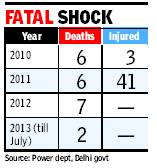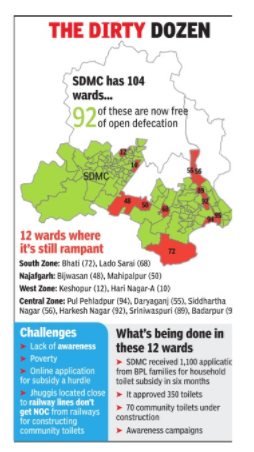Delhi: Civic issues
(→2017-18: SDMC earns big revenues) |
(→Metro: The Delhi Metro (DMRC)) |
||
| Line 302: | Line 302: | ||
The jury, however, is still out on whether the intent to punish violations in the city is matched by the will to ensure they are not repeated. | The jury, however, is still out on whether the intent to punish violations in the city is matched by the will to ensure they are not repeated. | ||
| + | =Manual scavenging= | ||
| + | See 'Scavenging, manual' below | ||
=Metro: The Delhi Metro (DMRC)= | =Metro: The Delhi Metro (DMRC)= | ||
See [[Delhi: Metro rail]] | See [[Delhi: Metro rail]] | ||
Revision as of 10:16, 22 October 2018
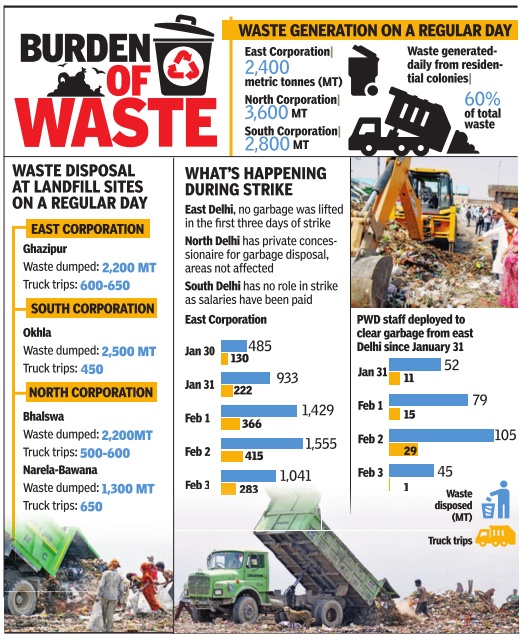
This is a collection of newspaper articles selected for the excellence of their content. |
Advertisements, outdoor
2017-18: SDMC earns big revenues

From: Mayank Manohar & Paras Singh, Visual clutter a poor advertisement for city, September 25, 2018: The Times of India
For ₹200cr In Revenue, South Corporation Turns A Blind Eye To Mess...
Every 10 metres on the stretch of Outer Ring Road near Lajpat Nagar market, you can see advertisements of a private company. No probable space, including unipoles and toilet complexes, has been spared. Maheshwari Devi, who frequents the market, is aghast. “You don’t see any empty space along the road and it all feels so congested,” she said. “There is a certain orderliness to hoardings compared with earlier times, but they have certainly overdone it.”
This visually loathsome vista of advertising boards across south Delhi brings a sparkle to the eyes of the South Delhi Municipal Corporation officials, who are eyeing an income of over Rs 200 crore from ads this year. They willingly turn a blind eye to the clutter, as do the two other municipal corporations, despite the Supreme Court instructing, when clearing the outdoor advertising policy formulated with the help of the courtmandated Environment Pollution Control Authority in August 2017, that while managing hoardings, effort should be made “to avoid visual clutter and ensure safety of the people as well as aesthetics”.
Under the policy, the capital is divided into clusters, each eligible to hold 60-70 unipoles, or advertising structures comprising single steel columns. Certain norms are to be followed, like a 75-metre distance between two unipoles, keeping pavements free of hoardings and giving the array of hoardings a uniformity.
The norms are flouted openly by firms that have won the rights to the clusters, and the civic bodies seem happy to ignore these. TOI noted the 75-metre rule being violated by the cluster operator on flyovers and in commercial hubs in south Delhi and the density of unipoles there was much higher than prescribed. In areas like Lajpat Nagar and along Vikas Marg, Akshardham Road and Mathura Road, unipoles were planted on pavements in flagrant violation of the norm. Each unipole brings in Rs 3-4 lakh per month.
There, however, is a grey area in the policy that gives the corporation officials the ground for permitting the clutter. The advertisement policy may mandate a separation of 75m between two unipoles, but only 5m is necessary to separate two mupis, which are smaller boards used for advertising, and no specific direction has been issued for flagpoles, which occupy a space similar to a mupi.
So, when asked about the clutter on the roads, an SDMC official was quick to explain, “There is no limit on the number of mupis that can be installed on any stretch. We have clubbed it with street furniture, and the agency using mupis is also expected to maintain the dustbins, police booths and toilets.” He added that there is no restriction to the placement of flagpoles so long as “pedestrian movement is not restricted”.
Despite the obvious advantage taken of the policy’s ambiguity, Prem Shankar Jha, deputy commissioner of the advertisement department in SDMC, maintained curbing the illegal use of unipoles was beneficial to the civic body. “We issued 1,500 legal notices and filed 950 complaints against the brand, not the local representative or PR firm. If the orders of top companies get cancelled, the market will automatically be disciplined.” But SDMC may not be keen to be overaggressive. It expects a big increase this year over the Rs 136 crore it earned from ads last year and the Rs 43 crore in 2015-16.
Meanwhile, B M Bakshi, president of the New Friends Colony RWA, complained, “The arterial road in our area is claustrophobic with ads. Forget about the 75-metre rule, every few steps you run into banners.” Civic officials claimed that monitoring was not possible due to depleted field staff. But as insiders revealed, the fact that many officials of SDMC’s advertisement department have been replaced for “foul play” indicates that there is money to be made for permitting illegal publicity.
but not the MCs of east and north Delhi
The ad revenues for East Delhi Municipal Corporation and its counterpart in north Delhi are low relative to what the south corporation gets. It isn’t as if the two civic bodies don’t have the infrastructure for ads. On Vikas Marg, Outer Ring Road and Noida Link road, there are unipoles on both sides of the road. Advertisers just aren’t interested in them.
EDMC has 110 unipoles and the north corporation has 700 in 15 clusters. But EDMC only got Rs 11 crore from unipoles last year, while the north body was able to auction off only seven of the 15 clusters. These clearly indicate that advertisers aren’t keen to spend money in these places.
“In east Delhi, we don’t get advertisers from big brands. Most of them want to advertise in south Delhi, in areas like Greater Kailash, Lajpat Nagar and Green Park,” said an EDMC official. “If you can see hoardings of branded products and expensive cars in south Delhi, here you will find products meant for lower economic strata.” It is for this reason, he claimed, that a unipole brought in, at most, Rs 1.35 lakh in monthly fees compared with up to Rs 4 lakh for SDMC.
Officials admitted that the low rentals and disinterest of advertisers were compounded by lax monitoring, but claimed EDMC’s advertisement department was handicapped by having a staff of just five, of whom two are private hirings.
In the north, the clusters that did not find bidders are useless as a revenue source. “We have been trying to auction those eight clusters, but in vain. So we plan to auction individual unipoles instead,” said an official. “The private ad firms do not want to pay the required Rs 26 lakh for a cluster unlike in south Delhi with its prime locations and advertisers with open purses.”
The north corporation official revealed that there are plans to add 300 unipoles to the existing 700, in the hope that ad revenues could improve by Rs 10 crore. “We hope to cross the Rs 50-crore mark in total earnings from advertisements this fiscal. Last year, we had collected Rs 33 crore from advertisement tax and we by increasing the number of unipoles alongside giving rights to the use of public spaces like toilets, transformers and electric poles, we think we can increase earnings by up to Rs15 crore,” the official added.
Unlike the south corporation, EDMC only got ₹11 crore from its 110 unipoles last year, while the north body was able to auction off only seven of its 15 clusters. Officials also point out EDMC’s advertisement department was handicapped by having a staff of just five, of whom two are private hirings
Cattle Shelters/ gaushalas
As in 2018

From: Paras Singh & Mayank Manohar, City gaushalas: Shelters or cash cows, August 12, 2018: The Times of India
Delhi’s Five Government-Funded Cattle Shelters Are Overcrowded, Financially Stressed And Score Poorly In Animal Welfare
Unable even to hold up their miserably bony bodies, the cows leave their filthy, overcrowded “wards” at the Acharya Sushil Muni Gaushala in Ghumanhera for Dabar Harekrishna shelter in Surhera. With the death of 60 animals in the past week and a half, the cow shelter, one of the capital’s five government-funded gosadans, is being sealed and the animals there are being shifted to other facilities.
“There were carcasses lying everywhere, and the place smelt and looked horrible, mired as it was with rain water mixed with urine and dung,” said Abhishek Kumar, the official from the animal husbandry department who had been among the first to reach the shelter for an inspection after the news broke. But long before this, the gaushala had turned into a cesspool of mismanagement and financial disputes.
“After the death of its founder, Sushil Muni, the inheritors started fighting over the funds,” disclosed Laxmi Narayan, a worker at the shelter. “The funding stopped and even fodder and water were not available for the 1,400-odd cows here.” But this shelter is not an exception. Records accessed by TOI show that around 3,500 cows have died every year in another shelter.
Over-crowded, always financially stressed and with no proper oversight mechanism, Delhi’s gaushalas are a metaphor for animal welfare gone wrong. There are five official gosadans located on the city outskirts at Surhera, Rewla-Khanpur and Ghumanhera in the Najafgarh region and Harewali and Bawana in northwest Delhi. Four are operating beyond their capacity, while fifth is now at its limit.
“No one is willing to take in the strays we capture because of the funding problem,” remarked a veterinary official of the North Delhi Municipal Corporation, which has channelled Rs 30 crore to the three shelters it send its cows to since 2012. Stray buffaloes are kept in cattle pounds and auctioned, but cows are tagged and sent to these officially funded shelters, which get Rs 40 per animal per day, equally divided between the corporation and Delhi government.
TOI found the gaushalas in Rewla-Khanpur and Ghumanhera in a state of utter neglect. When cows are sent to the shelters, the civic bodies tag them in the ear — pink tag for those from the north body, orange from south and yellow from east. “The 1,100 cows that arrived from Ghumanhera are not tagged,” revealed Satish Kumar, manager at the Dabar Harekrishna shelter. “This can only mean that actual stray cows sent by the municipal corporations have died and the shelter replaced them to continue getting funds.”
Villagers in Rewla-Khanpur alleged a similar “scam” in Manav Gosadan there. The shelter management refused to let TOI see the over 500 cows under its care. Manav Jain, chairman of the trust, appeared apprehensive and asked TOI to return later in the day. The aggressive guards ensured no photographs were taken. This shelter received over Rs 2.5cr from SDMC alone in the past four years.
SDMC released over Rs 5.5 crore in the last three years to shelters, but there are claims worth several crores pending. Krishna Yadav, chairman of the Dabar Harekrishna Gaushala, claimed the civic agencies owed him over Rs 3 crore. “We have the financial means to sustain the shelter on credit, but others don’t. That is why the gaushalas are failing,” said Yadav.
Gaushala managements also argued for revision, saying feed costs had increased. “One cow needs 5kg of dry and 10kg of green fodder daily. This costs over Rs 85 per day, but we are running operations on 2012 rates,” said one gaushala manager. Financing is a major setback for the shelters, which are all operating beyond capacity.
A north corporation official said that cattle from neighbouring states are a major problem. “If we are provided with vehicles and manpower, we can stop this influx within six months,” the official reasoned. The north civic body has four vans to catch stray cattle across north and west Delhi, resulting in inhumane conditions during transport. “The trucks are packed and animals are injured. Many die while being brought here,” said Yadav of Dabur Harekrishna.
A decade ago, after a similar cow mortality crisis, a committee headed by former minister Ramakant Goswami was formed to overhaul the functioning of gaushalas. It made important recommendations, including regular audit of accounts, formation of an oversight mechanism and the participation of public in management of shelters. The panel also recommended the revocation of licence for the gosadans at Ghumanhera, Rewla-Khanpur, Harewali, Bawana and Malikpur. None of these were ever implemented.
Doorstep delivery of services
2018: the facility is launched
At your service: Doorstep delivery makes debut, September 11, 2018: The Times of India

From: At your service: Doorstep delivery makes debut, September 11, 2018: The Times of India
After a long wait, the Delhi government launched its ‘Home Delivery of Public Services’ scheme, which has been projected as an attempt to eliminate corruption in various public-dealing offices.
Under the scheme, Delhiites can avail of 40 services — issuance of caste, income and domicile certificates, learner’s and permanent driving licences, transfer of ownership of vehicle and change in address on vehicle RC, new sewer and water connections, new ration cards and pension for handicapped among others — without standing in long queues at government offices.
Addressing a gathering at 58 locations, where the launch at Delhi Secretariat was broadcast live, chief minister Arvind Kejriwal said the government machinery was undergoing a revolutionary change. “This day is not historic merely for Delhi; I feel we are doing a unique experiment which will be followed at the international level. Till now we had heard about the home delivery of pizza, from today people of Delhi will have the government at their doorsteps through a phone call,” he said.
Calling it “a revolutionary work in governance”, the chief minister said, “It will save people’s time and they won’t have to pay touts to get their work done.”
According to the government, the service will not only remove the applicant’s direct interaction with officials and do away with the possibility of the involvement of touts, it will also help the government to ensure that eligible applicants get the desired document issued without any delay.
Gopal Mohan, adviser to the CM and the brain behind the scheme, said the movement of each application would be closely monitored and any delay on part of government officials would be looked into. “The ministers will get regular reports on number of applications received and services delivered,” Mohan said.
Kejriwal, accompanied by his cabinet colleagues and senior officials, also claimed that for the first time in the world, such a service was being provided by a government.
An applicant will have to dial the call centre number, 1076, to fix the appointment for the desired service and get the details of the documents required for the application. On the scheduled day and time, a mobile sahayak (facilitator) will reach the applicant’s house, fill up the form, upload the documents, take his photo and biometric details, and submit the application for an additional fee of Rs 50. The applicant will receive regular messages on his registered mobile number on the progress of his application.
The cabinet had approved the project in November 2017 but had to wait for two months before getting lieutenant governor Anil Baijal’s approval, prompting the AAP government to allege that the BJP-led Centre was stalling the project through the LG.
Baijal had initially sent back the proposal for reconsideration, arguing that the scheme had implications on “safety and security of women and senior citizens, possibility of corruption and bad behaviour, breach of privacy, loss of documents and unnecessary expenditure on government and people”.
He had also pointed out that 35 of the 40 services being offered in phase I were already online. The AAP government, however, had argued that there were still long queues at government offices and common people were suffering.
Kejriwal said that the government would provide 100 services at the doorstep of citizens within three months. Later, he tweeted that the proposed doorstep delivery of ration would become a reality soon. “I hope we will be able to overcome all hurdles and soon home delivery of ration will also become a reality.”
The government has hired a private company — VFS Global Services — to offer the doorstep service. Kejriwal said the government was spending Rs 12 crore to implement the scheme.
Sixty-six mobile sahayaks — six for each of the 11 districts — have been verified by the police.
Evictions, demolition of houses
2017
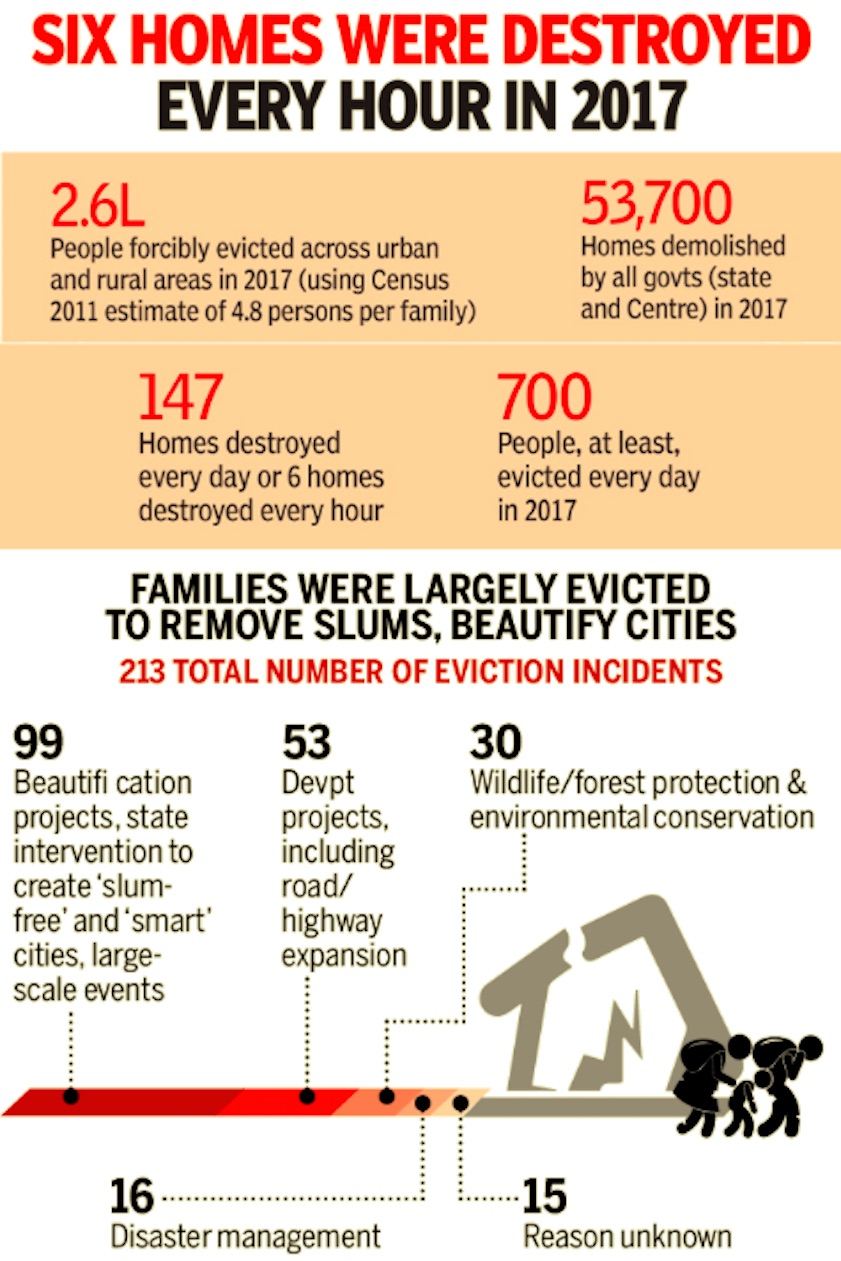
From: City beautification efforts rendered many homeless in 2017: Study, March 21, 2018: The Times of India

From: City beautification efforts rendered many homeless in 2017: Study, March 21, 2018: The Times of India
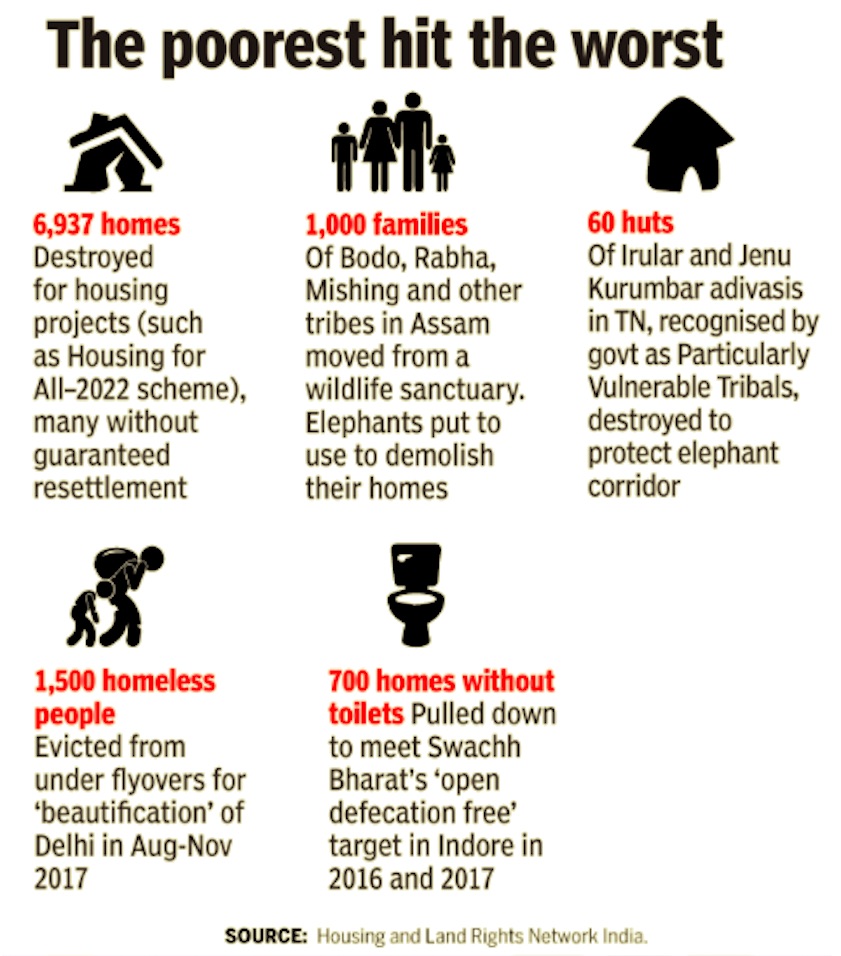
From: City beautification efforts rendered many homeless in 2017: Study, March 21, 2018: The Times of India
To build a road or community hall, or simply to beautify the city — thousands of homes were demolished, lakhs evicted in 2017, without any meaningful rehabilitation or resettlement measures, reveals a report by non-profit Housing and Land Rights Network India. The highlights...
Flyovers
Rainwater projects not built
The Times of India, Aug 03 2016
Neha Lalchandani
Flyovers fail harvesting test The monsoon mayhem that has been crippling Delhi for the past many years would have been long gone had civic agencies carried out rainwater harvesting along roads and flyovers following a 2007 high court order. While most flyovers that have come up since then bear some semblance of RWH, roads do not have any such system so far.
Vinod Jain, director of NGO Tapas, who had filed a plea in the high court in 2005, said the order was issued in 2007 but the agencies had not achieved much progress.“PWD has started implementing RWH on its flyovers. While the system on new structures is still alright, that on old flyovers is often faulty or not properly maintained,“ he said.“For instance, a multi-department team that inspected the AIIMS flyover last year found that the pits were clogged with garbage. At the Panchshila and Andrews Ganj flyovers, pipes meant to carry water open up on the road itself while at the Chirag Dilli flyover, the RWH system has been connected to the storm water drain.“
Jain will be approaching the National Green Tribunal on Wednesday with a plea that waterlogging on roads can be prevented if agencies are made to carry out RWH along roads.
According to an NGT order of August 2015, no flyover or bridge can be approved witho ut RWH. PWD officials claim that all its new flyovers and elevated roads have built-in RWH system and they are, in fact, using a new technique to improve collection of water. “We have carried out RWH on our new elevated road from Meera Bagh to Vikaspuri. For the first time, we have received no complaints of waterlogging on the Azadpur flyover. We are also using a new material and a better filter system, which can collect about 95% of the runoff,“ said an official.
The Delhi Metro too has been asked to carry out RWH and it has provided pits at 464 locations with a capacity of 8,607 cubic metres. “In the past one year, 93 new rainwater harvesting pits have been added,“ said a DMRC spokesperson.
However, DMRC has provided drains to keep its elevated tracks free from waterlogging, which run along the pillars supporting the tracks and open up a few feet above the road.Thousands of litres of water each monsoon have been flushed onto main roads, adding to the waterlogging problem.While DMRC says that it is the responsibility of road owning agencies to provide for drainage of this water, an official from PWD claims their drains were made several years ago and do not have the capacity to deal with the additional water flow.“DMRC cannot pump such quantities of water onto roads and expect others to clean up after them,“ said an official.
Meanwhile, of the three municipal corporations that own a majority of roads in the city, east and north civic bodies have not made any provision for RWH on their roads. Some work has been done by the South Corporation with officials claiming that a majority of the 104 wards under it have carried out small-scale RWH at 3-5 sites each. However, most of these RWH pits are next to drains where water level may already be high enough for the system to be ineffective.
Foot overbridges
40% are not used/ 2017
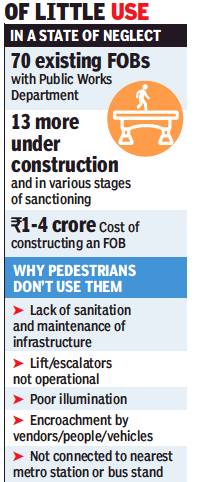
From: Risha Chitlangia, Built at ₹1-4 crore each, here’s why 40% of foot overbridges in city aren’t used, December 5, 2017: The Times of India
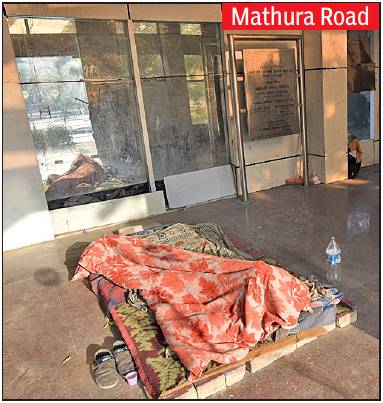
From: Risha Chitlangia, Built at ₹1-4 crore each, here’s why 40% of foot overbridges in city aren’t used, December 5, 2017: The Times of India
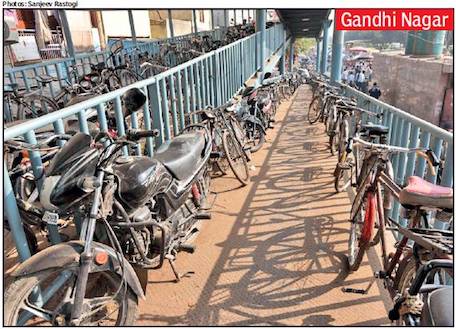
From: Risha Chitlangia, Built at ₹1-4 crore each, here’s why 40% of foot overbridges in city aren’t used, December 5, 2017: The Times of India
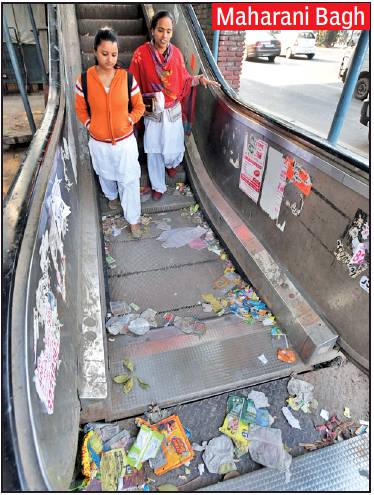
From: Risha Chitlangia, Built at ₹1-4 crore each, here’s why 40% of foot overbridges in city aren’t used, December 5, 2017: The Times of India
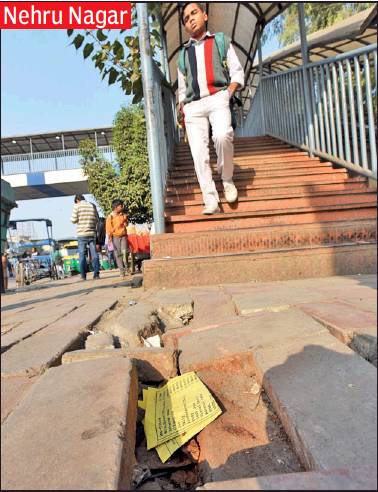
From: Risha Chitlangia, Built at ₹1-4 crore each, here’s why 40% of foot overbridges in city aren’t used, December 5, 2017: The Times of India
Badly Maintained, Most FOBs Have Waste Strewn All Over Even As Others Are Used As Illegal Parking Lots
It is one of the city’s busiest foot overbridges because it provides the safest way across the maddening traffic on Ring Road, but the elevated walkway at Maharani Bagh is in decrepit state. The escalator towards Maharani Bagh has not been working for days. Waste is strewn on the staircases and escalators, the flooring of the structure is broken and the fibreglass covering is missing in several places.
“Though it is not properly maintained, people are forced to use it because it is impossible to cross the road, especially at peak hours,” said Vishvesh Tiwari, a local resident. At a time when Delhi government’s Public Works Department is keen to erect new FOBs, it would do well to look at how well the existing ones are maintained, especially those fitted with escalators or lifts.
Just two kilometres from Maharani Bagh is the Nehru Nagar FOB. It too is in a similarly dismal condition. “We prefer to walk up the steps because the escalators often don’t function,” said Ishika, a student in a school in Nehru Nagar.
At Ramesh Park and Pragati Maidan, the lifts have been inoperable for weeks. “One of the lifts is not working, and spare parts have been ordered,” said Hridesh, lift operator at Ramesh Park. Once state-of-the-art, the FOB at Pragati Maidan near Purana Quila, constructed during the Commonwealth Games in 2010, is in a dire state. The glass façade is damaged, the lifts don’t work and the place is like a garbage dump.
While PWD has outsourced the maintenance of lifts and escalators to private agencies — a lift operator is deployed at each FOB — the fact is that the facilities are not looked after.
Encroachment is another bane. At Gandhi Nagar, one of Delhi’s busiest markets, people have taken over the space under the FOB to use as a parking lot for twowheelers and cycles. “There is no space left for people to walk and they have to risk their lives to cross the road,” complained Nikhil Jain, who works at a shop there. “Bikes and cycles are chained to the railings, leaving no space for pedestrians. On top of that, the place is ill-maintained.”
Another reason why people don’t use this FOB is due to the absence of lifts or escalator. As Jagat Singh explained, “This is a wholesale market and people buy stuff in bulk. Since there are no lifts or escalators, people carry their burden and cross the road instead of doing some climbing.”
Due to their odd location, some FOBs are rarely used. For instance, the FOB near Jawaharlal Nehru Stadium is rarely used because people easily negotiate the road traffic to cross the road. Constructed by SDMC, the FOB is now in derelict state. The iron railings are missing, the lift is not operational and the space has been encroached upon.
PWD officials admitted that maintenance of FOBs was a serious concern. Sources said there was a plan to outsource the maintenance of FOBs on a public private partnership model, but couldn’t be implemented.
“We are planning to revive the proposal because the maintenance of FOBs has become a serious issue. Currently, they get cleaned once every 10-15 days,” an official said.
Garbage
HT Cables, Low-Lying: Accidents Due To
North East Delhi
Death hangs low over NE Delhi colonies
Accidents Due To Low-Lying HT Cables A Harsh Reality That Authorities Are Blind To
Naziya Alvi Rahman TNN
The Times of India 2013/07/26
Residents of northeast Delhi’s Mandoli village, Harsh Vihar Colony and Meet Nagar say they have now been living with the 11KV line passing through their terraces for over three decades now.
This wire and the homes have co-existed in this area since around 1980.
While Harsh Vihar and Meet Nagar are unauthorized colonies, Mandoli village, where the latest casualty occurred, is a Harijan basti where in 1986 houses were allotted under a scheme to benefit members of the SC/ST communities.
Power officials say that in March this year the department under a 2009 policy had released a few crores to MLAs of unauthorized colonies to fix the problem. As per the policy, the expenditure was to be equally divided between the power department and MLA (from the MLALAD fund). Following this, discoms [electricity supply companies] were told to prepare a scheme for shifting HT lines of 11kV and 33kV and LT lines of 400V from all residential areas.
What do HT and LT mean?
Sayalee explains: Yahoo
HT means High Tension and LT means Low Tension.
Generally at the point of generation of electricity, the voltage is about 6.6KV (6600 volts). This is transported near user points where through a transformer, it is reduced from 6.6KV to 440V or 240 V as the case may be. This is done through steps using step down transformers. 240V, which is used as domestic electricity, can be termed low voltage. 440 V is generally used for driving various industrial motors etc.
Domestic electricity can not be used directly from HT as it is certain to damage your electrical equipments (like TV, mixer, fridge etc). Electricity comes to a residence, after stepping down to 240 V and not before that.
Illegal ‘colonies’: The regularisation of
CAG: Colonies regularized only on paper
Ambika Pandit TNN
The Times of India 2013/08/11
New Delhi: Expressing its concern that hundreds of crores spent by the Delhi government to develop unauthorized colonies might have gone down the drain, the CAG has said that regularization of these colonies remains only “on paper”.
The damning CAG report, awaiting the Sheila Dikshit government’s response, questions almost every aspect of its efforts to regularize the unauthorized colonies.
Though the CAG has audited 895 colonies, the government is looking at an inflated list of 1,639 so as to expand its votebank in time for this year’s assembly and the 2014 Lok Sabha elections.
CAG flays regularization claims
Ambika Pandit TNN
New Delhi: Expressing concern that Rs 542 crore spent by the Delhi government on development of unauthorized colonies might be in vain, the comptroller and auditor general has said regularization of these colonies remains only “on paper”.
The CAG report, currently awaiting the Delhi government’s response, questions almost every aspect of the Sheila Dikshit government’s efforts to regularize 895 unauthorized colonies ahead of the assembly polls later this year.
The auditor deals with the 895 colonies though the government is looking at a list of 1,639 unauthorized colonies. Their regularization is a key part of the Congres’s election strategy to woo a large section of voters, with 1,200 colonies given provisional regularization certificates (PRCs) just ahead of the last assembly elections in 2008.
The audit points out noncompliance of regularization formalities within 12 months of the issue of PRCs as promised in the amended guidelines of 2008. “These amendments and deletion of sub-clauses allowed the state government to announce regularization of 895 colonies without clearance of layout plans, change of land use, without collection of development charges by local bodies…. These formalities are still to be completed by the state. Thus, the period of 12 months set out still remains on paper,” the report observes.
CAG has said the government had released Rs 631 crore for development work between 2007 and 2012 to agencies and Rs 542 crore were spent tentatively but “…one or the other basic services (mandatory for regularization according to Supreme Court orders) like water, sanitation, drains and roads are unavailable”.
The auditor has also said it has received only a fraction of all the files it needs and much of the record is not available. “Detailed status of development work along with utilization certificates, physical and financial status have not been provided to audit till date.” The money has been released to various agencies like MCD, DSIIDC, DJB, PWD and the irrigation and flood control department.
The audit points out the procedure adopted for fixation of boundary by the Delhi government violates the 2008 regularization guidelines that were further revised in 2012.
Urban development secretary R K Srivastava told TOI: “It is our constitutional responsibility to reply to audit and we have done so in nearly 50% of the audit memos so far. Files are moving all the time as decisions on regularization are still being taken. The audit teams are being provided with the documents. CAG will file the final report after taking our replies into consideration.”
The report said the regularization claims might be misplaced. The government “has declared the colonies as regularized without proper verification of boundaries fixed from the revenue department and DDA, which is irregular and misleading to the general public”, the report has said.
The audit inspection report cites the September 2012 order of regularization where the Delhi government declared 312 colonies on private land as regularized and said 583 colonies on government land will stand regularized from the date of recovery of cost of public land. But this was never done.
Going back to 2008, the CAG said, “The issue of PRCs does not change the status of the colony as the secretary, UD, stated that there was no pre-condition of issue of these certificates before regularization of unauthorized colonies.”
The auditor has said the expenditure incurred on issue of PRCs was an excess burden on exchequer as the certificates did not alter the status of the colonies as they were not linked to fulfilment of norms regarding any basic services.
THE RED MARKS FINDINGS OF THE ONGOING AUDIT
Government’s September 4, 2012 notifi cation regularizing 895 colonies violates Supreme Court orders that make basic services like sanitation, water, drains and roads mandatory for regularization
Funds for development works in unauthorized colonies not monitored. Between 2007 and 2012, 631.3 crore released to MCD, DSIIDC and other departments but only 542.3 crore spent
Issuing provisional regularization certifi cates that have no legal sanctity, in 2008, led to wasteful expenditure
Government announced regularization without clearance of layout plans, change in land use and collection of development charges by local bodies
Colony boundaries fi xed without verifi cation by revenue department. Deputy commissioners ordered to conduct walk-through surveys and videography after the regularization order was issued
Violating the revised guidelines of 2012, the government fi xed boundaries on the basis of satellite imagery, not the layout plans submitted by the residents’ societies
No NOCs obtained from local bodies; boundaries fixed without considering infrastructure projects in the way can pose legal hurdles
Lal Dora
2006-2018
Ambika Pandit and Paras Singh, May 10, 2018: The Times of India
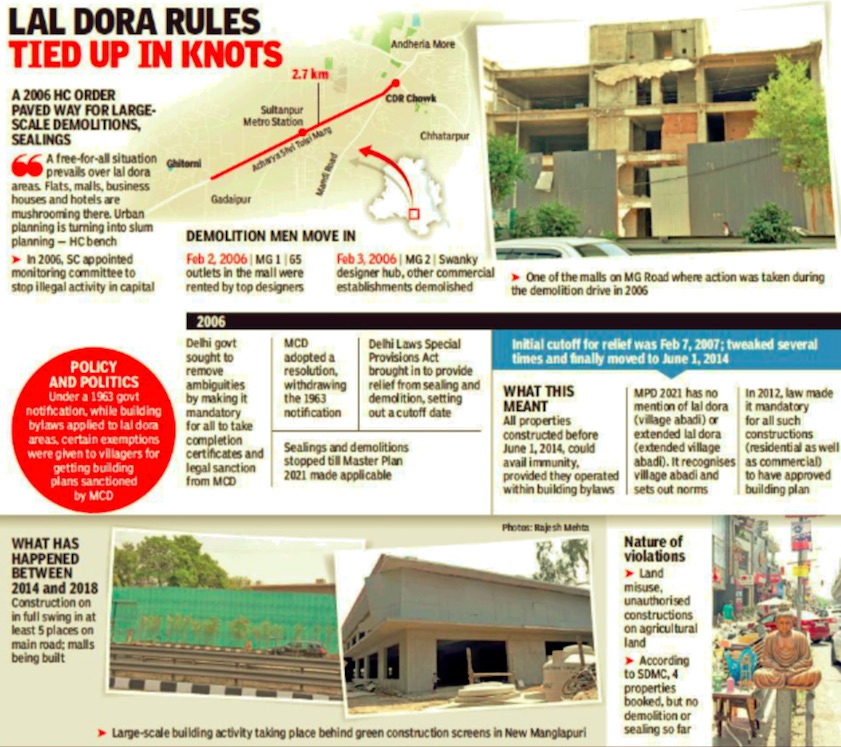
The 2006 HC judgement and demolitions;
2006-2018: violations of the order
From: Ambika Pandit and Paras Singh, May 10, 2018: The Times of India
The news is that the current drive to clear areas of encroachment, as directed by the Supreme Court, is successful for the day. Apparently, within hours the encroachers return to the place from where they were evicted. But is this too surprising?
The experience of a dozen years ago should have alerted the civic authorities about the pitfalls of demolishing without a long-term plan in mind. On February 1, 2006, bulldozers brought down building after building along the fashion designers’ hub that the Mehrauli-Gurgaon Road had become. The message had been clear: violations will not be tolerated, no matter how rich or famous the owners. A drive along the road today, however, proves the lack of force behind that intent.
The demolitions on MG Road were the result of Delhi high court observing on January 18, 2006: “A free-for-all situation prevails over lal dora areas. Flats, malls, business houses and hotels are mushrooming there. Urban planning is turning into slum planning.” The court, pointing out that unauthorised construction was causing parking and infrastructure-related problems, asked the then Municipal Corporation of Delhi to bring down all illegally erected structures. On February 1 of that year, the fashion fraternity watched in disbelief as bulldozers went at the glass-and-granite facades of two malls, where India’s A-list designers had outlets. The drive also saw showrooms being sealed across what in the land records constitute New Manglapuri, Sultanpur and Ghitorni villages.
When TOI revisited the urban villages recently, the two malls stood semi-demolished in the company of residential properties, farm houses, motels and showrooms. A resident of a house adjoining one of the malls narrated how they had to take precautions during strong winds because the danger of falling concrete slabs from the half-wrecked building could not be discounted. Once a large chunk fell on his car, the man said. The building owners did take care to barricade the site, but last week’s storm brought down the metal sheets, leaving the dilapidated structure open to view.
Down the narrow road clogged with cars and showrooms stocks, construction activity was visible. The posterior portion of a building sealed in 2006 is today a plush showcase of high-end furniture and furnishings. South Delhi Municipal Corporation officials explained that this section was desealed after the Special Provisions Act, 2014, amended the laws and paved the way for existing buildings to escape demolitions and shutdowns. Permission for reconstructing the front part, however, hasn’t been given. Many other buildings on the road received the benefit of the Special Provisions Act, though the law still does not allow new construction. But unmindful of this provision, a single-storey commercial centre has come up in the neighbourhood.
TOI noticed large-scale building activity taking place behind green construction screens in New Manglapuri. Then as one advanced towards Ghitorni, large concrete beams became visible at a corner. Nearby, an open construction site reflected the confusion over whether new erections were allowed or not. The most blatant violations appeared near the metro station where two mall-like structures are coming up. SDMC claimed to have booked these for unauthorised construction. An irate local said, “The violators initially block the visibility of the site by installing a wall, green screens or bamboo guards. Once the construction is completed, this veil is dropped and the building presented as existing before the implementation of the new norms.”
SDMC officials argued that most properties like these two were recently “booked” by the civic body and action will be taken at some stage. “We have booked four properties near Ghitorni and Sultanpur under Sections 343, 344 of the Delhi Municipal Corporation Act dealing with demolition or stoppage of work at unauthorised constructions,” one of the officials said. However, some area residents provided TOI photographs of various sites from a few months ago indicating how such “bookings” had not stopped the constructors. An SDMC official said, “We apprised the Supreme Court monitoring committee of the matter and its members told us to be prepared to take action. But politicians and businessmen say that showrooms here don’t constitute misuse and are protected by the Special Provisions Act. The matter is under scrutiny and a decision will be taken soon.”
The civic official said, “New structures coming up are certainly illegal. The area has become a mess due to too many rules being applied, including those related to a transit-oriented corridor, facility corridor, lal dora extension land and unauthorised colonies.” The spokesperson of the south corporation also affirmed that any fresh construction was illegal and liable to face action. The jury, however, is still out on whether the intent to punish violations in the city is matched by the will to ensure they are not repeated.
Manual scavenging
See 'Scavenging, manual' below
Metro: The Delhi Metro (DMRC)
Monkey menace
2018: sterilisation of monkeys stillborn
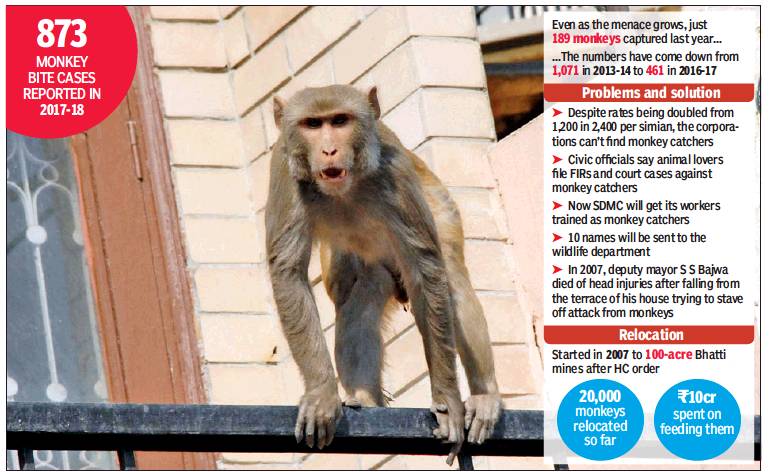
From: Jasjeev Gandhiok, Sterile fight: Why city is getting no closer to ending monkey menace, August 29, 2018: The Times of India
Forest Dept Gets No Bids For Sterilising City Simians
For the second time in three months, the forest department has failed to get a single bid for carrying out sterilisation of monkeys.
The Delhi government, in a status report submitted in the Delhi high court recently, had stated that the task of trapping and sterilising around 25,000 monkeys in the capital would cost around Rs 23.5 crore. The Union environment ministry had dubbed the amount too high and asked the government to revise the proposal.
A senior forest official said that while long-term measures for controlling the growing monkey population were ongoing, short-term plans would need a relook. “The next hearing is on September 20. We will inform the court that we will look to work with the corporations to find a solution to the problem. While the cost estimate can be revised, we still need people to carry out sterilisation,” the official said.
Testing on long-term measures is currently on at the Wildlife Institute of India and the National Institute of Immunology is working on immune-contraceptive vaccines — a mechanism used abroad to “sterilise” the animal within minutes. Officials said the work on vaccines and the testing process might take over three years. Experts said displacing monkeys to carry out surgical sterilisation could make them more aggressive. Gauri Maulekhi, an animal activist, had written to the forest department, highlighting how pilot projects had failed in Himachal Pradesh and Agra.
Open defecation
The 12 worst wards in South Delhi
South Corp Caught Up In Procedures “I do not go to toilet after 5pm because it is not safe,“ said Muskan, a Class VII student in Lal Kuan in south Delhi. Her house does not have a toilet at home and her mother is aware of the risk of sexual assaults women face when relieving themselves in the open. So she has forbidden her growing daughter from venturing out after dark. Many women in Lal Kuan hold out like Muskan does after dusk. Lal Kuan falls in the Pul Pehladpur municipal ward, where 150 households have been without toilets. It is one of the 12 South Delhi Municipal Corporation wards, where work is on to make open defecation a thing of the past.
SDMC declared 92 of its 104 wards free of this social embarrassment in May , and hopes to include all the wards by October 2.
Of the 434 cities assessed by the Swachh Survekshan 2017, SDMC ranked a low 196th, its prestige marred by the existence of open defecation despite having more funds for sanitation than many of the cities surveyed.Large swathes of BPL families don't have toilets at home, a major obstacle being the cumbersome process of getting the Rs 4,000 given as subsidy to install latrines.
“They tell us to file an online application with details of our bank accounts when we don't have smartphones or internet access,“ grumbled Dular Chand of Pul Pehladpur. “In any case, the money is too little. A toilet costs Rs 10,000 to construct.“ Since manually submitted applications are not accepted at the SDMC zonal office, Nand Kishore, father of six children, like many others, has not applied for the financial assistance.
With the date for freeing south Delhi of open defecation just three months away , mayor Kamaljeet Sehrawat has decided the online application system can be bypassed. “If a BPL family sends me a letter requesting toilet subsidy , I will accept it as an application. After officials verify the applicant's details, we will release the subsidy ,“ declared Sehrawat.
But the same level of commitment is missing in SDMC's offices. One executive engineer, for instance, could not even name the two wards under his jurisdiction where work on providing toilets was going on. His boss did not know names of the deficient 12 wards. On Thursday, SDMC or ganised an awareness campaign in some wards, an official informed. Such steps are important considering that many families, like those in Kusumpur Pahari, continue to defecate in the open despite adding toilet facilities to their houses with SDMC assistance.
The social problem is most visible in areas lying close to railway tracks and big drains. In such places, the Delhi Urban Shelter Improvement Board is mandated to provide community toilets, but the rail authorities have not given permission for the use of their land for the purpose.
“This is a hurdle in our effort to free the 12 wards of open defecation,“ said SDMC spokesperson Mukesh Yadav.
Parks
2017: 18,000 parks in city; 500 have children’s infrastructure
See graphic : The state of Delhi’s parks, 2017
See graphic: Some initiatives by RWAs and corporations
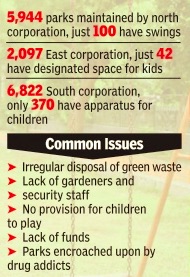

In Most Cases, Apparatus In Sorry State; Citizens Look To Find Own Answers
A park is one of the few areas left in the cities for children and their games.It is for this important reason that in 2015 Delhi high court ordered the municipal corporations to ensure dedicated playing space in every park in the capital. But while the civic bodies have focused on installing open gyms in colony parks, they have not paid much attention to the high court's directive.
Of the 18,000 parks maintained by the three municipal corporations, only 500 have recreation infrastructure for children. But even among them, the apparatus installed are now in a dilapidated state and can prove dangerous to children.
The onus of meeting the court's instruction has fallen on the RWAs. In Greater Kailash, for instance, the residents' association has taken up the revamp of the S Block park, where the apparatus installed by SDMC lies broken and decrepit. “We have spent our own money to install playground equipment for children as the existing ones have rusted or pose a threat to children,“ said MK Gupta, president, RWA, S Block.
After deploying private staff to maintain the park, Gupta said they were adding a basketball court to the areas for cricket, football and badminton that the RWA created.“The RWA collected the fund, we received no help from SDMC,“ said Gupta.
In Greater Kailash II too, RWAs have developed the park and provided adequate play space. “Many parks have swings but that is only meant for small children. The teenagers did not have space for playing, so we developed a small football ground for them,“ said Chetan Sharma, resident of Greater Kailash II.
Senior officials from So uth Corporation, however, countered claims that the parks were not properly manned or equipped. “We have sufficient staff to manage the parks and have installed apparatus for children in 370 parks,“ claimed a senior SDMC official.
In areas under the two other civic bodies, the situation is the same. Whatever play infrastructure was once erected is now corroded and unfit for use by children. In Mayur Vihar Phase II, Shipra Sinha said that the recreation apparatus had been changed a few years ago, but not since. In Pocket A, the park is frequented by drug addicts and antisocials. “The environment is not good, and we don't allow our children to play there,“ said Sinha.
In Karol Bagh, residents were satisfied with the state of their parks, not with the space earmarked for children. Ritu Kapoor complained, “The parks here are very small, and in this congested area there are no other places for children to play.“ She felt the civic body need to develop new spaces for children to indulge in outdoor activity.
Many parks have become garbage dumps, though officials of EDMC continue to argue that trash is not allowed to be thrown in or accumulate in parks. “We have installed 35 open gyms and as soon as we have some fund we also plan to develop parks for children,“ said one of them.
In Malkaganj, Vinod Singh pointed out that illumination was a big problem.“The lighting in the parks often fails and so people are reluctance to use the park for strolls in the evenings,“ he said. The status is similar in most localities, save those where the RWAs have taken it upon themselves to care for the precious green spaces.
Road digging
The issues: 2012-17
See graphic.
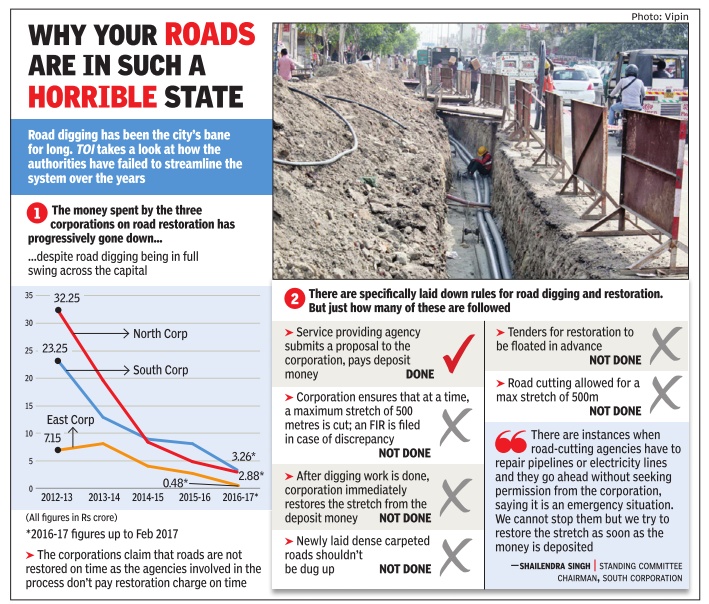
Scavenging, manual
77 deaths since the 1993 ban
77 deaths since 1993 ban on manual scavenging, August 8, 2017: The Times of India
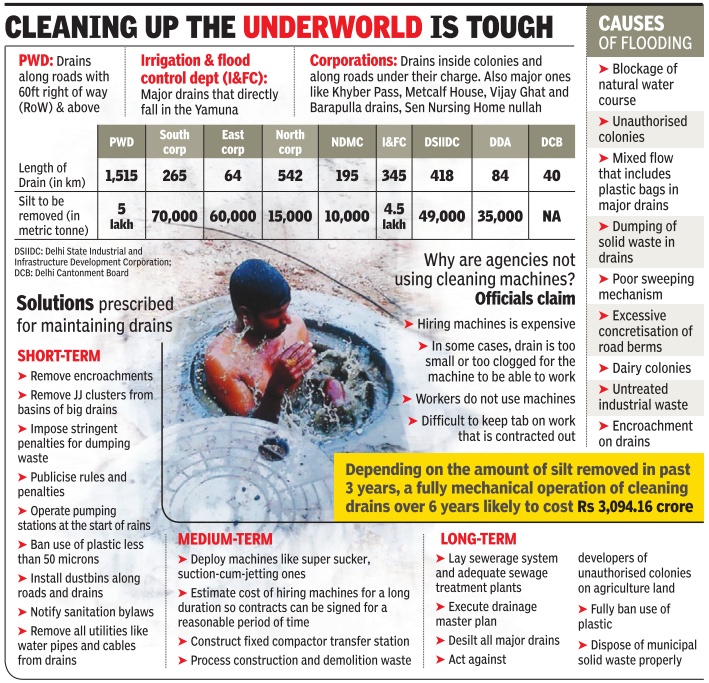
The death of three sanitation workers while cleaning a drain in Lajpat Nagar on Sunday takes the total number of recorded deaths of manual scavengers in Delhi since 1994 to 77. Manual scavenging was banned in the country in 1993 and agencies like the municipal corporations, Public Works Department and Delhi Jal Board (DJB) claim that their drains are cleared mechanically .Still, at least 77 people have died in Delhi since 1994 while cleaning drains.
A day after the three lost their lives, Delhi Jal Board had not determined why the men entered the sewer in the first place. Water minister Rajendra Pal Gautam said no engineer had owned up to taking the responsibility , each saying that they had no idea about the incident. “We have to wait for the report before we can take any action. The contractor who was getting the work done is absconding.When he is caught, we hope he will be able to name the officials from DJB involved in getting the drain cleaning work done. In any case, all our work is mechanised and we don't allow people to enter the drain,“ he said. DJB's stand on the issue was slammed by Magsaysay award winner Bezwada Wilson, working with manual scavengers since decades.
“How long will the government stand and watch people die and not accept its role in their deaths. However, this has now gone beyond DJB. The government has to take responsibility for these deaths. Both the Centre and the state are supposed to be making technological developments. The prime minister is talking of bullet trains but not of sewer deaths. He tweets all day but there has not been a single word from him on these deaths. The CM has not spoken a single word on them or announced any compensation. The Safai Ka ramchari Andolan will start a country-wide agitation very soon,“ he told TOI.
Wilson, who has been sending memorandums to all MPs over the past several months apprising them of the condition of sanitation workers and the failure of agencies to follow the law on manual scavenging, said that those responsible for Sunday's incident should be booked under the SCST Act as only Dalits were involved in the work of cleaning drains and septic tanks.
Despite what various governments have claimed, the ministry on social justice and empowerment accepted the prevalence of manual scavenging across the country in 2015 when it said that according to “the Houselisting and Housing Census, 2011, there are about 26 lakh insanitary latrines in the country .Accordingly , Parliament passed the Prohibition of Employment as Manual Scavengers and their Rehabilitation Act, 2013“.
Despite this, the three municipal corporations have employed 2,382 nala beldars or drain cleaners. DJB also employs beldars but says that they are not being asked to enter drains since 2014 as all cleaning work is mechanised.
Toilets in Delhi
48,000 families without toilets
Ambika Pandit TNN
The Times of India 2013/09/01
New Delhi: Sanitation and hygiene emerge as serious concerns in the Delhi Human Development Report 2013. While 90% of households in Delhi have access to latrines within their homes, 7.2% use public toilets and the rest defecate in the open.
Citing data drawn from the 2011 Census, the report states: “In the context of an urban agglomerate like Delhi…the provisioning of reliable sanitation facilities is also closely entwined with improving the security of women and children.”
It states women and children who use open spaces for defecation are “more vulnerable to exploitation”. The district-wise data shows that around 20% of the households in New Delhi district in the heart of the city use public toilets.
“Close to half of the slum households did not have latrine facilities within their premises, according to Census 2011 data, which has important implications for the hygiene situation in and around slums. The slum households account for 10% of Delhi’s total population. In absolute numbers 48,000 households were forced to defecate in the open,” the report states.
Most respondents in the survey rated public toilet facilities as poor, with 54.5% rating them as below average or very poor. Women also expressed fear about going out to defecate along railway lines near slums.
To reinforce the need for well maintained public toilets the report cites a 2012 baseline survey under Delhi Government’s flagship project, Mission Convergence. The survey on water, sanitation and hygiene was carried out across 19,683 households. It found that more than half of the slum children defecate in the open: “52% of the children living in slums and unauthorized colonies defecate in the open. This share is as high as 79% for children aged less than 3 years old. Amongst children above 3 years of age, 56% of the girls and 48% of boys defecate in the open,” the report states.
LIVING WITH INEQUALITY
17 lakh residents were below the poverty line in 2011-12 even though the city’s per capita income was Rs 2 lakh per annum
Housing shortage declined from 2.5 lakh to 1.5 lakh units between 2001 and 2011 but overcrowding continues. More than 10% of houses are vacant
56,000 people homeless as per state-UNDP survey in 2010
More than half of the lowest income households live in one-room dwellings whereas 40% of households in high income groups live in houses with three or more rooms
45% of people from the lowest income category spend 20-40% of their income on rent
Water availability has increased but 40% of residents in unauthorized colonies say availability is inadequate
10% of households without toilets at home. They use public toilets or defecate in the open
Trees
15,000 trees cut, 2014-17
15,000 trees cut in Delhi in 3 yrs, Rajya Sabha told, April 11, 2017: The Times of India
Over 15,000 trees have been cut in Delhi for undertaking various developmental and construction activities in the last three years, the Centre said.
Environment minister Anil Madhav Dave, in a written reply in the Rajya Sabha, said while in 2014-15 fiscal, 6,161 trees were cut, in 2015-16 financial year, 4,689 trees were cut. The number of trees cut in 2016-17 was 4,759.
The total number of trees cut in these three financial years was 15,609, he said.
Dave pointed out that Section 10 of Delhi Preservation of Trees Act, 1994 prescribes that every person, who is granted permission under this Act to fell or dispose of any tree, will be bound to plant such number and kind of trees in the area.
Why trees are at risk in Delhi
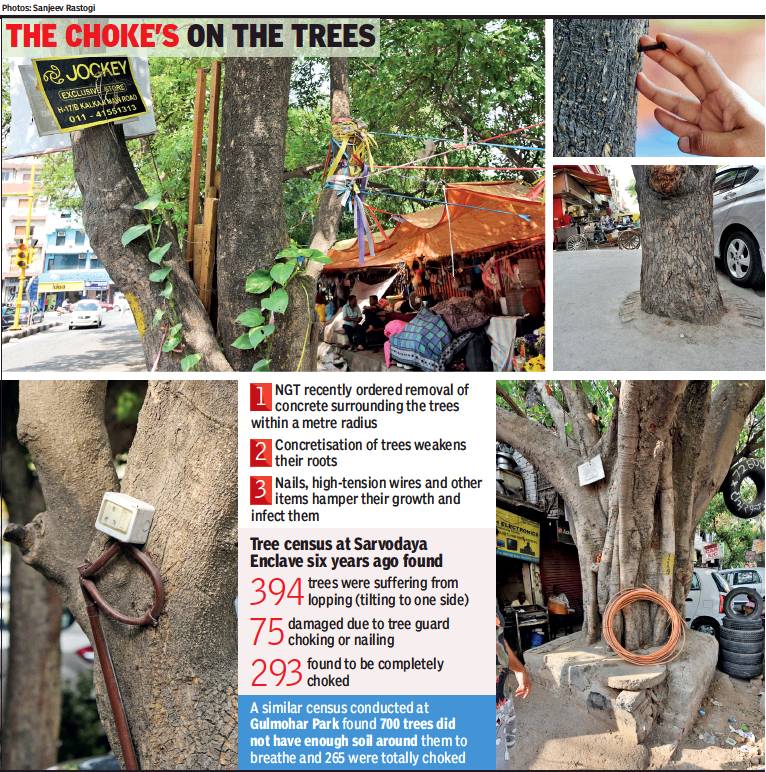
From: Jasjeev Gandhiok, 255 trees uprooted in over 2 hrs, here’s why they are at risk in city, May 14, 2018: The Times of India
The tree under which you seek respite from the 40 degree Celsius sun may actually be surviving against all odds, or maybe not. This was demonstrated by the storm in the capital on Sunday, with the strong winds knocking down at least 255 trees across the city.
What leaves them susceptible to the vagaries of nature? The answer appears simple: look anywhere in the city and you will find their roots likely choked by concrete, their trunks riddled with nails and strangled by wires. Advertisement boards continue to be hammered into trees and concrete poured around them to facilitate car parking in complete violation of Delhi high court’s 2009 order that all trees should be left 6x6 feet of ‘breathing space’ around them at the ground level.
On Sunday, as many as 32 trees were uprooted in the storm in Lutyens’ Delhi alone. Elsewhere, Mayur Vihar, Patparganj, Laxmi Nagar, Karol Bagh, Okhla, CR Park, Greater Kailash, Dwarka and Daryaganj were majorly affected.
A few days ago, when TOI visited New Friends Colony, Pamposh Enclave, Greater Kailash-I and Shivalik Colony in south Delhi, tree activists spoke of this dismal situation. They claimed to be fighting a losing battle, with their repeated complaints to the forest department, municipal corporations or the horticulture department eliciting little response.
“We can remove nails from trees, as we did in south Delhi’s New Friends Colony last year, but for larger things such as high tension wires, street lights or concretisation around tree trunks, we can only alert the authorities,” said Verhaen Khanna, founder, New Delhi Nature Society.
The National Green Tribunal recently reiterated that no concrete should be used in a one-metre radius around tree trunks. It also directed: “Ensure that all the signboards, names, advertisements, any kind of boards or signage, electric wires and high tension cables or otherwise are removed from the trees forthwith.” But, as green activist and advocate Aditya N Prasad, the petitioner in the NGT case, pointed out, very little has been done in this direction.
The number of trees that topple over in storms should alert the civic agencies to the dangers of cement-restricted tree trunks. “Concretisation of the space around trees not only restricts water from percolating into the soil, but also constricts the root growth. This then causes the tree to tilt and fall down during heavy winds,” explained Prasad.
Padmavati Dwivedi, who conducted Delhi’s first tree census in Sarvodaya Enclave six years ago, was assured that the NGT petition and efforts of nature lovers has made some difference. However, she still has her worries. “Some space is now being left for the trees, but not as specified by NGT. Besides, trees in so many localities are yet to be de-choked,” Dwivedi said.
The 2012 Sarvodaya Enclave Census had found 394 trees suffering from lopping (tilting to one side), while 75 had been choked by tree guards or nails. In addition, 293 trees, or 41% of the colony’s trees, were found completely strangled, and only 172 had two feet of space around them. A similar census at Gulmohar Park established that 700 of the 1,100 trees there did not have enough soil around them to be able to breathe.
Unsafe Buildings
‘Unsafe’ Old Delhiwallas live in fear and hope
Survey On Unsafe Buildings Pending, No Repairs This Year
Maria Akram TNN The Times of India
Every year, the corporations carry out a survey before monsoon to identify unstable structures and get them repaired. In 2012 the corporation pointed out some 160 dangerous buildings in the city.
North Delhi Municipal Corporation says the guidelines are very clear, and residents should file complaints against officials who demand money. “Repair includes patchwork, mending the ceiling, whitewash or changing the windows. But one cannot extend the height of the structure. There have been complaints of people carrying out construction in the name of repair.”
Officials say over 200 buildings in Walled City area and around 70 in Paharganj are not deemed safe but only 27 dangerous buildings have been strengthened in the past few years. Officials say most of the dangerous buildings are private properties. They claim to have issued several eviction notices but put the onus of repairs on the owner. “In 2012, 25,785 properties were surveyed in the Walled City and 47 were declared ‘very dangerous’. We issued notices but the owners are responsible for demolishing the portions. If the building is marked as ‘very dangerous’, we raze the portions and the owners are supposed to remove the remaining structure,” said a North Corporation official.
According to the figures by the National Crime Records Bureau, Delhi has experienced maximum damage by collapse of structures, falling under unnatural accidents, among 53 cities. In 2011, 68 cases of collapse were reported, claiming 60 lives and leaving 75 people injured. This raises serious questions about the capital’s readiness for vertical gr owth.
After the Lalita Park building collapse in 2010, then unified MCD, along with the National Institute of Disaster Management, conducted a large-scale survey in the trans-Yamuna area to pinpoint the unsafe buildings. The survey report was never tabled. After the collapse, action has been taken against 96 properties, say officials.
“Rampant illegal construction has not only cluttered areas but also weakened the existing structures. The walls of many houses have developed cracks and their foundation has become shaky,” said Sanjeev Sehgal, member of Ramesh Nagar RWA, east Delhi.
WITHERING HEIGHTS
Every year municipal corporations have to carry out a survey to identify dangerous buildings in the capital
1n 2012, corporations identified around 160 dangerous buildings
Officials say there are over 200 dilapidated buildings in Walled City and over 70 in Paharganj alone
Under Delhi building bylaws 1983, no alteration can be made to a residential building after the building plan is sanctioned by corporation. For any change in basic structure, a new building plan has to be submitted; otherwise it will be seen as unauthorized construction
CHANGES ALLOWED
Plastering and patch repair
Replacing fallen bricks, stones, pillars, beams, etc
Reconstruction of portions of building damaged by rain, fire or any other natural calamity to the same extent and specification as existed prior to damage
Erection or re-erection of internal partition provided it is within purview of bylaws
Building norms, fire safety certificates, some accidents
Somreet Bhattacharya, 1980s' norms fail to keep buildings safe , May 11, 2017: The Times of India
High-rises in Lutyens Delhi were mostly built in compliance with the building norms of 1980s. But with changes in the layouts, the designs have become outdated as far as present safety measures are concerned.
The consecutive fires at Antriksh Bhawan has left the fire officials worried. Officials said that most of the blazes in these high-rises are caused due to the exposed wirings in the building, which were built according to the norms of the time they were erected. While all of them had clearances from the fire department while being constructed, most were not renewed.
Under the new rules, the fire safety certificate issued is valid for 5 years for residential buildings (other than hotels) and 3 years for non-residential buildings, including hotels from date of issue. Officials said that a fire clearance certificate is not a guarantee that the building will never meet with an acci dent, it just means that a reasonable fire safety measure has been taken. It also depends on the maintenance of the building, they said.
“Under DFS rules 2010 of Delhi Fire Service Act 2007, the occupier of the building or premises, as the case may be, should maintain the fire prevention and safety measures provided in the building or premises at all times,“ said chief fire officer Atul Garg. The department conducts regular surveys on safety of these building, but said that there have been no changes in the structures built on the basis of norms of 1980s.
Almost all cinema halls, guest houses, big malls and high-rise buildings in the city have been issued an NOC by the department.
Waterlogging/ flooded roads
The extent of the problem
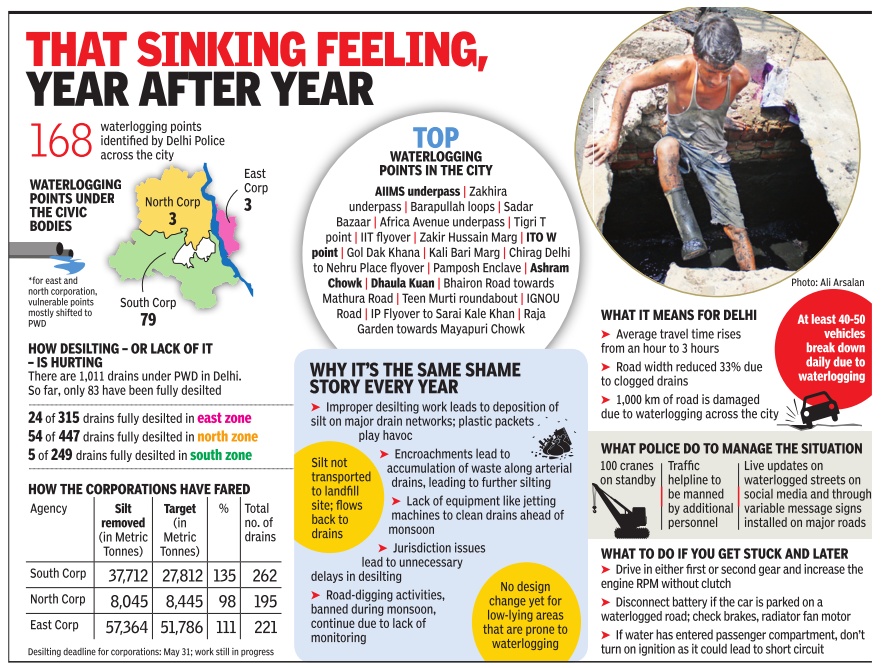
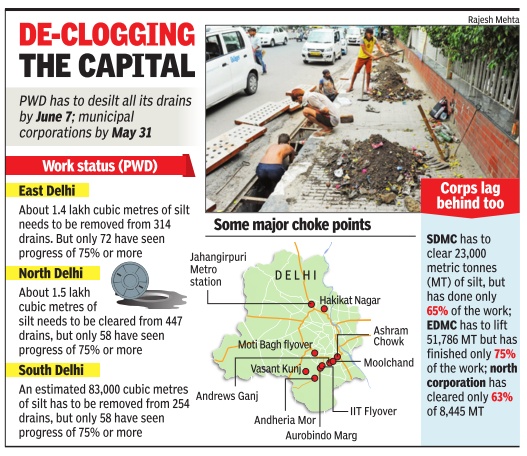
See graphic:
Waterlogging in Delhi
Desilting the drains—some major choke points, as in June 2017
The worst affected areas in 2018, Sept
It rains again and Delhi doesn’t know whether to laugh or cry, September 3, 2018: The Times of India
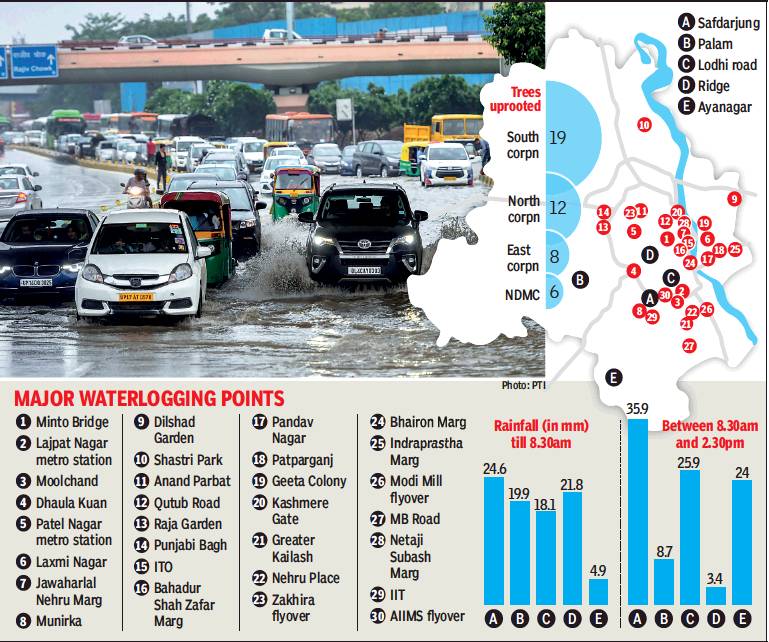
From: It rains again and Delhi doesn’t know whether to laugh or cry, September 3, 2018: The Times of India
Showers Bring Relief From Heat But Large Parts Of City Waterlogged
For the second straight day, Delhiites woke up to strong showers that brought traffic to a standstill and left many areas waterlogged. Till 8.30am, Safdarjung received 24.6mm of rain. It recorded another 35.9mm in the next nine hours, met officials said. Delhi’s regional met office said similar activity was expected for the next three days.
It forecast moderate rain for Monday with the maximum and minimum temperatures hovering around 29 and 25 degrees Celsius, respectively.
As many as 45 trees were uprooted across the capital, according to reports from the corporations and the traffic police. Delhi government had in April directed civic agencies to ensure that all their drains were desilted so that the problems of the past years weren’t repeated. The tall claims of the agencies, however, remained on paper. Due to choked drains, most of the major stretches were submerged in knee-deep water.
At several places, commuters were stuck at metro stations after the entrance and exit gates were flooded. Flyovers at Dhaula Kuan, Moolchand and Minto Bridge were waterlogged too.
A road near Kaushik Enclave in north Delhi's Burari reportedly caved in following which the traffic police alerted commuters not to take that route, a traffic police officer said.
“We have deployed pumps and staff in our areas. Control rooms have been set up that work 24x7 to address the grievances of people. We have received complaints of waterlogging and fallen trees from 19 areas and officials have been directed to take appropriate action,” a senior south corporation official said.
Hitting out at the AAP government and BJP-led municipal corporations, Delhi Pradesh Congress Committee chief Ajay Maken alleged that both had “failed” to come up with a permanent solution for waterlogging.
The national capital of India had become the “capital of waterlogging”, Maken said.
“AAP government and the MCDs seem to be fighting with each other just for showoff. Had both worked to come out with a permanent solution on waterlogging, Delhi, the capital of India, would not have become the capital of waterlogging (sic),” he said in a statement.
IIT-D’s solution
Paras Singh, July 19, 2018: The Times of India
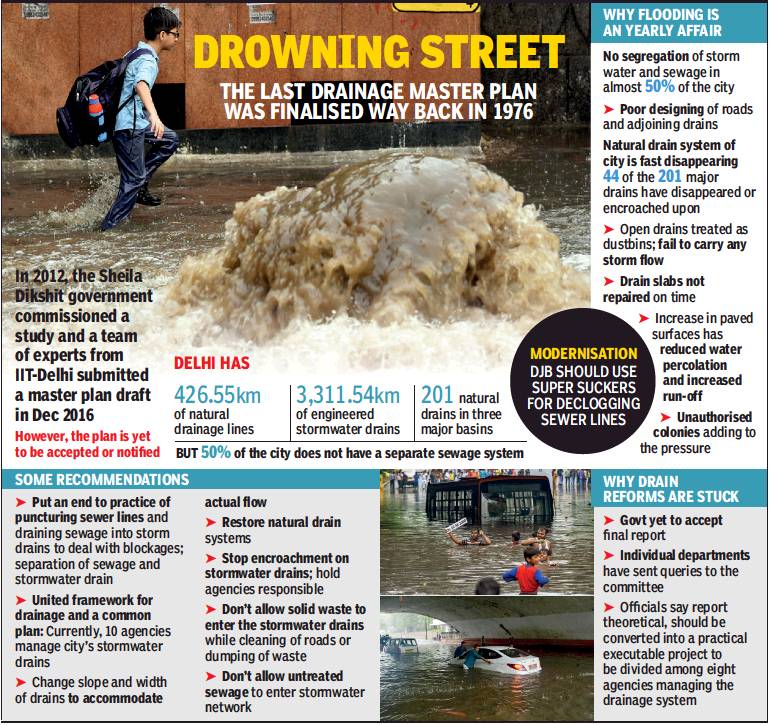
From: Paras Singh, July 19, 2018: The Times of India
In 2012, Sheila Dikshit, chief minister of Delhi at the time, remarked that the last drainage master plan for the city had been made in 1976 and there was a need to prepare a new plan, keeping in view the fast-changing scenario in the capital. She announced that IIT-Delhi was being tasked with coming up with a new master plan. Now, almost six years later, as the much-needed master plan remains mired in red tape, the city is repeatedly brought to its knees by massive waterlogging even during moderate rainfall.
It’s more than 18 months since the IIT experts submitted the draft drainage plan in December 2016, but Delhi government has not accepts its recommendations as yet.
Professor AK Gosain, who headed the team that devised the master plan, said that the team has scientifically quantified the carrying capacity of Delhi’s 3,700 km of drains and the volume of water that flows in them. “We made recommendations on everything in the system that needs rectifying, such as slopes of drains, width adjustments, siltation removal and revival of natural drainage,” Gosain said. Gosain rued the government “has not done anything so far” and feared the new framework was irretrievably struck in the bureaucratic maze. “Nobody wants to do any work, and the systems for executing changes are not in place,” he remarked.
One of the important recommendations was the restoration of the city’s natural drain system. Manoj Mishra of the Yamuna Jiye Abhiyan was aghast when he said, “The 1976 drainage master plan identified 201 major natural drains. Now government officials say that 44 of those cannot be located.” He added that most of the remaining drains too were “permanently silted up” to an extent that no one knew their actual dimensions any longer. “The only immediate solution is to completely clean the storm water and sewage system. This should be our first priority,” Mishra declared. The draft recommendations have also highlighted the need for the stormwater drainage system to remain free of sewage and solid waste.
Other key recommendations of the master plan include complete separation of the networks carrying sewage and storm water, unified framework for drainage with a common plan, laying down of pipes to convey rainwater from the surface to nearby parks or water bodies and the revival of natural drains. Former PWD engineer-inchief Sarwagya Srivastava observed that fewer than half of Delhi’s houses were connected to the sewage network. “Sewage from across Delhi flows into the stormwater drains, which are not designed to carry sewage and so get choked,” Srivastava said. He caustically commented that instead of the annual, three-month-long blame game over desilting, Delhi needed a comprehensive waterlogging plan that included the revival of natural drains. “Drains like Barapullah and Najafgarh haven’t been desilted for several decades. Other drains have been encroached upon, leaving only a tiny pathway for the water.”
Srivastava, however, opined that the IIT report was “only a theoretical report”. It had to be converted into a practical project report allocating specific works to different departments. After the submission of the report last year, Delhi government’s department of irrigation and flood control department was entrusted the responsibility of working with IIT-D on specific, master plan-based projects to improve drainage. Government officials said the draft recommendations were sent to all departments that manage the drainage system for their views.
DJB chairman Dinesh Mohaniya, meanwhile, said that the work of separating sewage lines was taking place on an aggressive footing even if the deadline for the task under the earlier master plan is 2031. He, however, claimed ignorance of obstacles in the path of the new master plan.
Speaking about the current crisis, Professor Rakesh Khosa, another member of the IIT team that prepared the draft plan, said the “bureaucracy and the dysfunctional institutional leadership” were also to be blamed. “The drainage issues are not simple challenges, and the absence of competent and skilled leadership is the biggest among the challenges,” he declared.
A known bane is the multiplicity of agencies and the absence of a common framework on drainage. There are 10 agencies, including the municipal corporations, PWD, DSIIDC, DDA, and the irrigation and flood control department, to manage the 3,700 km of drains.
